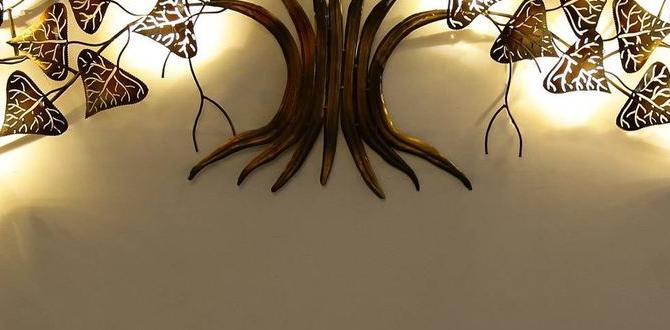Edible landscaping turns your yard into a delicious, productive garden. Learn to grow fruits, vegetables, and herbs right alongside your flowers, transforming unused spaces into food sources. It’s beautiful, practical, and makes a greener, tastier home.
Edible Landscaping: Your Genius & Essential Guide to Growing Food Where You Least Expect It
Ever look at your garden beds, borders, or even shady corners and think, “This space could be doing more”? Many of us dream of fresh, homegrown produce but feel overwhelmed by traditional vegetable gardens. The good news is, you don’t need acres or a dedicated plot to grow your own food. Edible landscaping is a brilliant way to weave delicious plants into your existing outdoor (and even indoor!) spaces. It’s about making your garden both beautiful and bountiful, one tasty plant at a time. Get ready to transform your yard into a living pantry, and don’t worry, we’ll walk through every simple step to make it happen!
What Exactly IS Edible Landscaping?
Edible landscaping is the practice of designing your garden spaces so that the plants are not only attractive but also produce food you can eat. Think vibrant berry bushes nestled among your ornamental shrubs, fragrant herb borders lining your walkways, or even edible flowers sprinkled throughout your flower beds. It’s about thinking beyond purely decorative plants and integrating fruits, vegetables, nuts, herbs, and even edible flowers into your overall landscape design.
Instead of just looking pretty, your landscape becomes a source of fresh, healthy food for your table. This approach is incredibly versatile, working beautifully in small urban yards, sprawling country homes, and even on balconies and patios. It’s a sustainable and beautiful way to boost your home’s biodiversity and your family’s nutrition.
Why Choose Edible Landscaping? The Many Delicious Benefits
The appeal of edible landscaping goes far beyond just having fresh ingredients at your fingertips. It’s a holistic approach to gardening that benefits you, your family, and the environment.
Beautiful & Functional Spaces
Many edible plants boast stunning flowers, interesting foliage, and delightful textures, just like their ornamental counterparts. Imagine the deep red of a raspberry bramble, the silver-green leaves of sage, or the cheerful yellow of squash blossoms. These can add incredible visual interest to your garden throughout the seasons.
Fresh, Healthy Food
The most obvious benefit is access to incredibly fresh, nutrient-rich produce. Harvesting ingredients minutes before eating them means maximum flavor and nutritional value. Plus, you significantly cut down on your food miles and any potential pesticide exposure from store-bought produce.
Sustainability and Eco-Friendliness
Growing your own food reduces your carbon footprint by eliminating transportation and packaging associated with purchased groceries. Edible landscapes also support local wildlife and pollinators by providing food and habitat. They can improve soil health and even contribute to managing stormwater runoff.
Cost Savings
Over time, growing your own fruits, vegetables, and herbs can significantly reduce your grocery bills. While there’s an initial investment in plants and supplies, the long-term savings are substantial, especially if you’re growing staple crops or frequently used herbs.
Educational Opportunities
Edible landscaping is a fantastic way to teach children (and adults!) about where food comes from, the cycles of nature, and the importance of healthy eating. It’s a hands-on learning experience that fosters a deeper connection to the environment.
Space Efficiency
This method is perfect for maximizing the use of your available space. You can integrate edibles into existing flower beds, use vertical growing techniques, or even plant productive crops in containers, making it ideal for any size property.
Getting Started: Planning Your Edible Landscape
Embarking on your edible landscaping journey starts with a little planning. Don’t feel like you have to transform your entire yard overnight! Start small and expand as you gain confidence.
Step 1: Assess Your Site
Before you dig, take time to understand your yard. This is the most crucial step for success!
- Sunlight: Observe how much sun different areas of your yard receive throughout the day. Most vegetables need at least 6-8 hours of direct sunlight, but some leafy greens and herbs can tolerate partial shade. Note areas that are sunny in the morning versus the afternoon.
- Soil: What’s your soil like? Is it sandy, clay-heavy, or loamy? Performing a simple soil test can tell you about its pH and nutrient levels. The EPA offers resources on soil testing, which is important for understanding what amendments might be needed.
- Water: Where is your water source? Consider how you’ll water the plants, especially during dry spells. Sloping areas might require different watering strategies than flat beds.
- Existing Plants: Are there trees or shrubs you want to keep? Consider their mature size and how they will interact with new edible plants.
- Wind Exposure: Windy areas can stress plants, so consider sheltered spots or windbreaks.
Step 2: Choose Your Edibles Wisely
Select plants based on your site assessment, your preferences, and what you’re likely to eat and enjoy. Start with plants that are known to be easy to grow and productive.
Easy-to-Grow Edibles for Beginners
- Herbs: Mint (in containers to control spread!), rosemary, thyme, sage, chives, parsley, basil. Many are perennial and come back year after year.
- Leafy Greens: Lettuce, spinach, kale, arugula. These tend to grow relatively quickly.
- Fruiting Plants: Strawberries, bush beans, peas, cherry tomatoes (in containers or trellised).
- Root Vegetables: Radishes, carrots (in well-dug soil).
- Edible Flowers: Nasturtiums, pansies, calendula.
Consider plants that fit your climate and local growing conditions. University extension offices are fantastic resources for local planting guides and recommendations.
Step 3: Design and Placement
Now for the fun part – figuring out where everything goes! Think about the aesthetics just as much as the function.
- Integrate, Don’t Isolate: Instead of a separate vegetable patch, mix edibles into existing garden beds. Plant colorful Swiss chard among flowers, use blueberry bushes as shrubs, or frame a path with rosemary.
- Consider Height and Color: Place taller plants at the back of beds and shorter ones in front. Use plants with varying leaf colors and textures for visual interest.
- Think Vertically: Utilize trellises, arches, or walls for vining plants like cucumbers, pole beans, and squash. This saves space and adds a vertical dimension to your design.
- Companion Planting: Some plants benefit from being near others. For example, basil is said to improve the flavor of tomatoes and repel some pests. Marigolds are known to deter nematodes in the soil.
- Accessibility: Ensure you can easily reach plants for watering, harvesting, and maintenance. Consider pathways.
Step 4: Prepare Your Beds and Plant
Good soil is key to healthy plants. If your soil isn’t ideal, you can amend it or incorporate raised beds or containers.
- Soil Improvement: Mix in compost and other organic matter to improve drainage and fertility. For clay soil, adding grit like perlite or coarse sand can help.
- Raised Beds: These offer excellent drainage and control over soil composition. They are also easier to access. You can build them from wood, stone, or metal.
- Containers: Perfect for patios, balconies, or areas with poor soil. Ensure containers have drainage holes and use a good quality potting mix.
- Planting: Follow the specific planting instructions for each of your chosen plants, paying attention to spacing and depth. Water them in well after planting.
Edibles for Different Garden Zones
Not all parts of your yard are created equal, but almost every area can support edible plants with the right choices.
Sunny Spots (6+ Hours of Sun)
These areas are gold for most fruiting vegetables and many herbs. If you have a sunny border or bed, consider these:
- Tomatoes: Bush or indeterminate varieties can be grown in beds or large containers.
- Peppers: Bell peppers, chili peppers – add vibrant color and heat.
- Eggplant: Their glossy fruits and purple flowers are stunning.
- Berries: Raspberries, blueberries (require acidic soil), strawberries (ground cover or in beds).
- Melons and Squash: Can be grown in sunny beds, with vines allowed to sprawl or trained upwards.
- Corn: Needs full sun and space, but incredibly rewarding.
- Sun-loving Herbs: Rosemary, thyme, basil, oregano.
Partial Shade Spots (3-6 Hours of Sun)
Don’t despair if you have shady areas! Many delicious things thrive here:
- Leafy Greens: Lettuce, spinach, kale, arugula, Swiss chard. These often taste sweeter with a bit of shade to prevent bolting in heat.
- Root Vegetables: Carrots, radishes, beets. While they might grow slower, they can still be productive. Ensure the soil is loose.
- Herbs: Mint (again, container recommended!), parsley, chives, cilantro, dill.
- Certain Berries: Some varieties of raspberries and blackberries can tolerate partial shade.
- Edible Flowers: Pansies, violets.
Shady Nooks (Less Than 3 Hours of Sun)
These areas are often overlooked but can still be productive with the right plants:
- Certain Greens: Some types of lettuce and spinach can tolerate deep shade.
- Mushrooms: Mushroom kits can be placed in cool, damp, dark areas.
- Certain Herbs: Mint is surprisingly tolerant of shade, as is parsley.
- Sorrel: A lemony, tart green that loves shady conditions.
Integrating Edibles into Existing Landscapes
You don’t need a blank canvas to start. Here’s how to weave edible plants into what you already have.
Ornamental Edibles: Beauty Meets Bounty
Many plants have dual purposes. Choose those with attractive flowers, foliage, or fruit:
- Blueberry bushes: Offer beautiful spring flowers, green summer foliage, bright fall color, and delicious berries.
- Raspberry and Blackberry bushes: Add structure and can be espaliered against fences.
- Strawberry plants: Can be used as ground cover or in hanging baskets, with lovely white flowers and red fruit.
- Ornamental Kale and Cabbage: Their colourful, ruffled leaves are stunning in fall and winter gardens.
- Artichokes: Their architectural, silvery foliage and large purple flower buds are impressive.
- Daylilies: Young shoots, flower buds, and petals are edible, and they add spectacular color.
Herb Borders and Pathways
Line your walkways or garden edges with culinary herbs. They release wonderful fragrances when brushed against and are always within reach for a pinch of flavor.
- Low-Growing Herbs: Thyme, oregano, and creeping rosemary can form a fragrant, living carpet.
- Upright Herbs: Sage, lavender, and Russian sage add height and structure.
- Ensure adequate sun and drainage for these sun-loving plants.
Fruit Trees and Edible Shrubs
Larger edible plants can replace or augment traditional ornamental shrubs and trees.
- Plant a dwarf fruit tree (apple, pear, fig) in a sunny spot.
- Use berry bushes like elderberries or aronia as hedges or focal points.
- Consider espaliering fruit trees against a fence or wall to save space and create a unique visual feature. Visit resources like the RHS for techniques on espaliering.
Edible Flowers
Sprinkle these cheerful blooms throughout your garden for color and a surprising garnish:
- Nasturtiums: Peppery leaves and bright flowers can be used in salads.
- Pansies and Violas: Mild, slightly sweet flavor, ideal for decorating desserts and salads.
- Calendula: Adds a sunshine yellow/orange hue and has mild peppery notes.
- Borage: Star-shaped blue flowers with a cucumber-like taste.
Container Edible Landscaping
Don’t have yard space? Edible landscaping can thrive in containers!
Best Edibles for Containers
- Herbs: Almost all herbs do well in pots.
- Salad Greens: Lettuce, spinach, arugula grow quickly and are easy to harvest repeatedly.
- Tomatoes: Look for “bush” or “determinate” varieties specifically bred for containers.
- Peppers and Eggplant: Smaller varieties are excellent for pots.
- Strawberries: Perfect for hanging baskets or tiered planters.
- Radishes: Fast-growing and don’t need deep soil.
- Bush Beans: Productive in larger pots.
Container Tips for Success
- Choose the Right Size: Deeper pots are better for root crops and larger plants like tomatoes. A minimum of 8-12 inches deep is good for most.
- Material Matters:** Pots can be ceramic, plastic, terracotta, or fabric. Terracotta dries out faster, while plastic retains moisture. Fabric pots offer excellent aeration.
- Drainage is Key: Ensure all containers have drainage holes. Sitting in water will kill most plants.
- Use Quality Potting Mix: Never use garden soil in pots, as it compacts too easily. A good potting mix provides aeration and drainage.
- Watering Needs: Container plants dry out much faster than those in the ground. Check them daily, especially during hot weather.
- Fertilizing: Nutrients leach out of pots more quickly. Feed your container plants regularly with a balanced liquid fertilizer or slow-release granules.
Key Tools and Supplies for Edible Landscaping
You don’t need a huge arsenal of tools, but a few basics will make the job much easier.
| Tool/Supply | Purpose | Beginner Recommendation |
|---|---|---|
| Hand Trowel | Digging small holes for planting, weeding. | A sturdy stainless steel trowel is durable. |
| Garden Fork/Spade | Turning soil, digging larger holes, breaking up compacted earth. | A good quality spade for general digging. |
| Pruning Shears | Trimming branches, harvesting herbs and some fruits. | Bypass pruners are good for clean cuts on live plants. |
| Watering Can/Hose with Sprayer | Essential for keeping plants hydrated. | A watering can is good for small spaces; a hose with a gentle spray nozzle for larger areas. |
| Gloves | Protect your hands. | Comfortable gardening gloves. |
| Compost/Organic Matter | Enriches soil, improves structure and fertility. | Bagged compost from a garden center or local farm. |
| Mulch | Retains moisture, suppresses weeds, regulates soil temperature. | Shredded bark, straw, or compost. |
| Containers (if applicable) | For growing on patios, balconies, or in poor soil. | pots with drainage holes. |
| Trellises/Supports (if applicable) | For vertical growth of vining plants. | Simple bamboo stakes or metal trellises. |
Maintaining Your Edible Landscape
Once established, your edible landscape will require ongoing care, similar to any garden.
Watering
Water deeply and less frequently rather than shallowly every day. Check the soil moisture by sticking your finger a couple of inches down. If it feels dry, it’s time to water.
Weeding
Regular weeding prevents competition for water and nutrients. Mulching helps significantly in reducing weed growth.
Pest and Disease Management
Healthy plants are more resistant. Practice good garden hygiene, prune out diseased parts promptly, and encourage beneficial insects. For minor pest issues, often a strong spray of water



